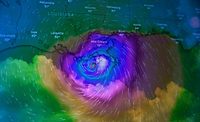5 ways to prepare for a winter weather emergency

We often think of snow and ice when we think of winter weather. But as Mother Nature has shown us with the latest La Niña cycle, winter can also bring devastating tornadoes, flooding, mudslides and fires. No area of the country seems to have escaped this winter's impacts.
Weather events are costly not only to the state and federal government, but to individual businesses. The winter storm last February in Texas brought the state to a standstill, and the cost of damages was as much as a major hurricane.
Neglecting to prepare businesses for costly winter weather events is asking for trouble. Just as private citizens might keep emergency tools in your car like blankets, water and a flashlight, enterprise security professionals should make the equivalent preparations for their organizations.
Let’s look at a few emergency preparedness tools security leaders can implement today.
1. Assess risk.
To understand what areas of a business could be affected, assess enterprise risk from various weather scenarios. Ask what property, people, operations or data could see impacts. This includes examining the organization’s supply chain, which may already be strained because of COVID-19. Use a tool like FEMA's Business Risk Assessment Table or engage a third party who specializes in risk management to help.
2. Develop a security plan for users and employees.
With winter weather, there are three scenarios security leaders may face regarding the protection of life. If a weather event is approaching and the organization has time, they may need to let employees go home early and close the business. When time does not allow, employees may need to shelter in place. Lastly, if there is a threat within or around the building, they may need to evacuate.
Having protocols in place for each scenario before a weather event saves precious time and helps security leaders avoid making an emotional decision in the moment. Some questions to ask include:
- What is the organization’s communication plan?
- Does the business have enough food, water and other emergency supplies onsite should staff or customers need to shelter in place?
- Where should people go when evacuating?
An emergency response plan can help security professionals answer these and other critical questions.
3. Put a business continuity plan in place.
A business continuity plan exists to help businesses remain open or quickly reopen after a weather event. It includes all information on insurance policies, employee protocols, essential functions, data and system backups, vendor backup options and more. If the organization is inaccessible for a time, it may need to resume operations from another site where employees and the security team can access critical company data. FEMA has a business continuity plan template security professionals can use to get started on a plan today.
4. Move goods and assets outside the storm impact zone.
Securing goods and assets is an essential step in protecting businesses from catastrophic loss and business disruption. In the case of weather events forecasted 24-72 hours out, protecting a business may mean moving goods and assets out of the predicted impact zone. This could include product stock, machinery and critical documents. The preplanning accomplished by a business continuity plan will help guide security teams in this area.
5. Monitor real-time intelligence from national and local authorities.
Emergency alerts can save lives and property. Encourage all senior leaders and staff to sign up for local and national alerts. The National Weather Service (NOAA) has several alert options to update security on impacts to the area. FEMA also has resources on available shelters. An organization’s emergency response plan should also include contact information for local police, fire departments, hospitals and emergency services. Make sure the organization’s communications plan includes notifying employees of all available resources.
Preparation is the best insurance policy against winter weather
It could only take one major weather event to put an organization out of business. Creating emergency plans ahead of time is the best way to protect a business from the damaging effects of winter weather. In some cases, this preparation may keep organizations from having to file an actual insurance claim.
Once an organization has an emergency plan in place, the foundation is there. Security leaders can simply refresh each plan the following year before winter weather strikes.Looking for a reprint of this article?
From high-res PDFs to custom plaques, order your copy today!







